Cabbage roll
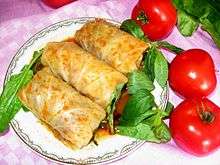
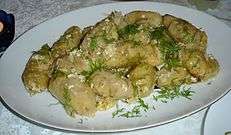
A cabbage roll is a dish consisting of cooked cabbage leaves wrapped around a variety of fillings. It is common to the cuisines of the Balkans, Central, Northern, Eastern Europe, and Iran, as well as West Asia and Northern China.
Meat fillings are traditional in Europe, often beef, lamb, or pork seasoned with garlic, onion, and spices. Grains such as rice and barley, eggs, mushrooms, and vegetables are often included. Pickled cabbage leaves are often used for wrapping, particularly in Southeastern Europe. In Asia, seafoods, tofu, and shiitake mushroom may also be used. Chinese cabbage is often used as a wrapping.
Cabbage leaves are stuffed with the filling which are then baked, simmered, or steamed in a covered pot and generally eaten warm, often accompanied with a sauce. The sauce varies widely by cuisine. Always in Sweden and sometimes in Finland, stuffed cabbage is served with lingonberry jam, which is both sweet and tart. In Eastern Europe, tomato-based sauces or plain sour cream are typical. In Lebanon, it is a popular plate, where the cabbage is stuffed with rice and minced meat and only rolled to the size of cigar. It is usually served with a side of yogurt and a type of lemon and olive oil vinaigrette seasoned with garlic and dried mint.
Popular among Europeans, and traditionally served among the Jewish on Simchat Torah, stuffed cabbage is described by Gil Marks to have entered Jewish cooking some 2,000 years ago.[1] Recipes vary depending on region; Romanians and northern Poles prefer a savory sauce, while Galicia and Ukraine favor sweet-and-sour, for example.[1]
Variations
|
|
|
Europe
Poland
Stuffed cabbage rolls are the epitome of Polish nourishment. Pork and beef mixed with rice or barley are nestled in a cabbage leaf and cooked in the oven or on the stove until tender.
Poles call them gołąbki, which literally means "little pigeons." For Czechs and Slovaks, it's holubky, while Serbs and Croatians refer to them as sarma. Usually, the sauce is what sets them apart. There's also a less popular version called 'leniwe gołąbki' (lazy cabbage rolls) in which ingredients are chopped, combined together and baked or fried.
Ukraine
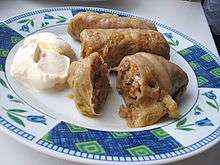
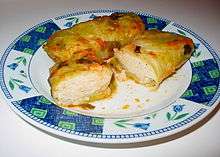

In Ukraine, the stuffings of holubtsi varied throughout the country. In the Carpathian regions corn grits were used; in the Poltava area buckwheat groats were preferred. The grain was lightly cooked, mixed with fried onions, pork cracklings, and on holidays––raw minced meat was combined with spices, and this mix was used to fill steamed fresh or pickled cabbage leaves. In the spring cabbage leaves were often replaced with fresh red beet leaves, and in the southwest––with fresh young grape leaves.
The holubtsi were lightly fried, placed in a cooking pot, and a sauce was poured over them. During Lenten periods this might be water mixed with kvas, while at other times it might be a meat broth. Sour cream would be added, and the holubtsi baked in a well heated oven. The holubsti were ready when the cabbage leaves were soft.
In Left Bank Ukraine and in the south, holubtsi are big, made from the entire cabbage leaf, while in the Dniester region and the Carpathians the cabbage leaf is divided into several pieces. In the latter regions, cooks who made large holubtsi were considered lazy. In Poltava cooks preferred the large holubtsi because they were juicier. In most of Ukraine holubtsi were an everyday dish, but in most of Right Bank Ukraine, with the exception of Polissia, they were also included in holiday meals. Beginning in the 1920s, holubtsi began to be stuffed with a rice-meat mixture, and, instead of kvas, they began to be cooked in tomato juice, sauce or paste. This is the most common way they are prepared nowadays.
It is hard to imagine the Ukrainian table, everyday or holiday, without holubtsi. For Sviat Vechir (Christmas Eve) Boykos and Transcarpathians make Holubtsi from “kryzhavky” (pickled whole heads of cabbage). Into these “pickled” holubtsi they put a stuffing of rice and mushrooms. Carpathian-style holubtsi are usually made from fresh cabbage and stuffed with corn grits, or with grated raw potato (Vorokhta, Verkhovyna, Kvasy). These are best served with mushroom gravy. To differentiate the different types of holubtsi, they are wrapped into different shapes: corn-filled ones are made into the shape of envelopes, with the edges folded in, potato-filled are simply rolled up. A classic Halychan (Galician) dish Sviat Vechir dish is holubtsi stuffed with grated potato and served with a mushroom machanka (dipping sauce).
Russia
The Russian version of cabbage rolls usually consists of mincemeat mixed with cooked rice or buckwheat wrapped in cabbage leaves and stewed in a mixture of sour cream and tomato sauce. In order to save time there is another variation of that dish called "lenivye golubtsy" (lazy cabbage rolls). In that case, the cabbage is chopped and mixed with mincemeat and rice so there is no need to wrap every meatball in a cabbage leaf.[3]
Sweden
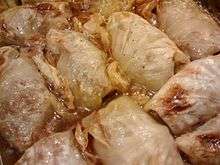

Kåldolmar are Swedish cabbage rolls filled with minced pork and in some cases rice. They are usually eaten with boiled potatoes, gravy, and lingonberry jam. Kåldolmar are also popular in Denmark and in Finland, where they are known in Finnish as kaalikääryle (plural kaalikääryleet).[4]
The dish is considered a variety of the dolma, common in Eastern Mediterranean countries. After losing the Battle of Poltava in 1709 Charles XII of Sweden fled to the city of Bender, in Moldavia, then controlled by his ally, the Sultan of the Ottoman Empire. Charles XII spent more than five years in the Ottoman Empire, trying to convince the Sultan to help him defeat the Russians. When he finally returned to Sweden in 1715, he was followed by some of the Ottoman creditors from whom he had borrowed money to finance his wars. The creditors lived in Stockholm until 1732, and during this time it is most likely that the dolma was introduced in Sweden.
The first known Swedish recipe for Oriental dolmas was included in a famous Swedish cookbook written by Cajsa Warg, in 1765. At the end of the recipe, Ms Warg suggested that those who could not afford vine leaves could use preboiled cabbage leaves in their place.
In Sweden "Kåldolmens dag" (Day of the Cabbage Roll) is celebrated on November 30, the day of the death of Charles XII of Sweden. It was instated in 2010 as a reaction to the recent rise in anti-immigration views by showing the purported long history of a multifaceted Swedish cultural heritage, involving national symbols with international background. It is arranged by "Kåldolmens vänner" (Friends of the Cabbage Roll).
Nowadays, frozen 'Kåldolmar' are sold in most big food stores.
Hungary
The traditional Hungarian cabbage roll (töltött káposzta) can be made from pickled cabbage leaves, filled with minced pork meat. The Hungarian version often contains minced pepper (paprika) and is served with sour cream on top. Hungarians serve this food during the periods of time near Christmas and New Year's, but stuffed cabbage also belongs to the traditional pig slaughter.
Romania and Moldova
.jpg)
Sarmale are Romanian stuffed cabbage rolls traditionally served on Christmas and New Year's Eve but also served throughout the year at weddings, baptism parties, and other large celebrations. Ground pork is mixed with sauteed caramelized onions and rice stuffed in a cabbage leaf, pickled sauerkraut leaf or grape leaf. For flavor, they usually consist of layers with smoked pork fat, smoked ribs, or smoked sausage.
The Romanian sarmale is a versatile dish, and the best way of consuming is reheated the next day. The flavor is different with an enhanced flavor. It can be prepared with a tomato base, dill base or combination. Sweet shredded cabbage layers in between the rolls of pickled cabbage leaves or sauerkraut layers in between of sweet cabbage leaves. The taste is significant different but still a great dish.
Serbia, Bosnia and Herzegovina and Croatia
Cabbage rolls are a staple diet of the population in Serbia and Croatia. Stuffed cabbage with smoked ground pork is a favorite at Christmas, in winter and at the wedding's. In Serbia, sarma is typically made with sauerkraut leaves.
North Africa
Egypt
In Egyptian cuisine, cabbage rolls are called محشي كرمب, pronounced maḥshī kromb or maḥshī koronb (as Standard Arabic [m] often turns to [n] in proximity to [b] in Egyptian Arabic), literally translating to "stuffed cabbage." The leaves are fresh and commonly cut into smaller pieces and partially pre-cooked. The most common filling is a mixture of rice, onion, tomato, herbs, and spices (most typically including mint, dill, and cumin); meat is rarely used in Egyptian stuffed cabbage. The rolls are arranged in a pot and boiled in broth or tomato-based sauce, also including the herbs and spices.[5]
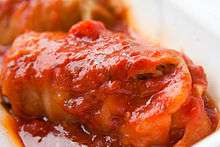
Americas
United States
In regions heavily influenced by Polish immigrants, such as Chicago which claims the largest Polish population outside of Poland, northern Pennsylvania, Southwestern Pennsylvania, the southern tier of New York, and northeastern Ohio, the term usually refers instead to stuffed cabbage rolls, such as the Polish gołąbki.[1]
See also
Notes
- 1 2 3 Eileen M. Lavine (September–October 2011). "Stuffed Cabbage: A Comfort Food for All Ages". Moment Magazine. Retrieved October 3, 2011.
- ↑ June Meyers Authentic Hungarian Heirloon Recipes Cookbook
- ↑ The ultimate Russian comfort food, October 28, 2009, Russia Beyond the Headlinese
- ↑ Kåldolmar recipe, Nature Teaches Us: A Comenius Project
- ↑ "Egyptian style stuffed cabbage leaves". Food.com. Retrieved 22 November 2013.
References
| Wikimedia Commons has media related to Cabbage roll. |
- Wretman, Tore: Svensk husmanskost (Forum 1967) ISBN 91-37-08274-4